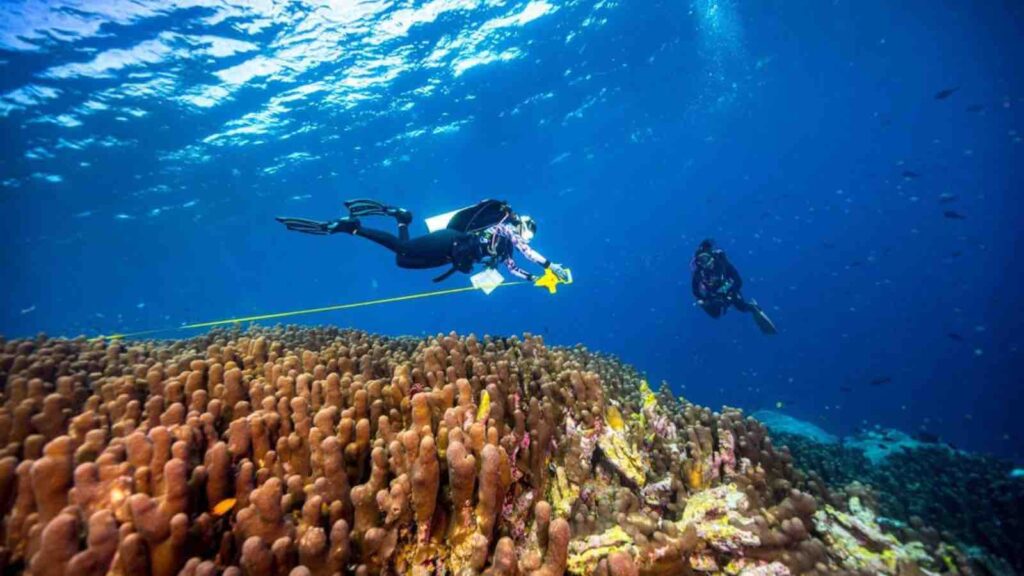The Galaxea astreata colony is now under the protection of the Nusa Penida MPA, and researchers hope it will become a focal point for marine conservation efforts in the region.
A team of young Indonesian marine biologists from the NGO Ocean Gardener has made an extraordinary discovery off the northern coast of Nusa Penida, Bali. The team has identified what could potentially be the largest coral colony in the world, a monumental find that underscores the ecological importance of this marine region.
RELEVANT SUSTAINABLE GOALS



A Record-Breaking Coral Colony?
The coral colony, named Galaxea astreata, measures an astounding 58 meters wide, 71 meters long, and 10 meters high, covering over 4,000 square meters. This makes it significantly larger than the current record-holder, a Pavona coral colony in the Solomon Islands, which measures 34 meters wide, 32 meters long, and 5.5 meters high.
“This discovery has the potential to set a new world record,” said Manikmayang, Ocean Gardener’s Research and Science Coordinator. “However, further testing is needed to confirm its status among the world’s giant coral colonies.”
The discovery was made after researchers from Ocean Gardener completed training under the Map the Giants program by Università Milano-Bicocca in Italy. The team stumbled upon the coral colony in early December, despite it being hidden in plain sight along a popular diving route frequented by hundreds of divers daily.
Why Nusa Penida is a Coral Giant’s Haven
Located in the Lombok Strait, Nusa Penida is uniquely positioned at the crossroads of the Pacific and Indian Oceans. This area, part of the Coral Triangle, is a global biodiversity hotspot where strong ocean currents create ideal conditions for coral growth. These currents allow corals to grow to monumental sizes while producing billions of larvae that reseed reefs across the Indian Ocean.
Nusa Penida’s marine ecosystems are already well-recognized, with the region designated as a Marine Protected Area (MPA) covering 20,057 hectares. In November 2024, the area gained further protection as a Particularly Sensitive Sea Area (PSSA) under the International Maritime Organisation (IMO), joining the ranks of globally significant sites like the Great Barrier Reef.
The Role of Conservation and Tourism
Nusa Penida is a thriving marine tourism destination, known for its manta rays, sunfish, and endangered turtles. Conservation organizations, including the Coral Triangle Center (CTC), have worked tirelessly to safeguard these ecosystems. The discovery of the Galaxea colony adds another layer of significance to the MPA’s role in global conservation.
“This is a monumental achievement after years of dedicated conservation work within the Nusa Penida Marine Protected Area,” said the CTC in a statement.
However, conservationists stress the importance of responsible tourism. Tourists diving or snorkeling in Nusa Penida are urged to follow strict guidelines to protect the delicate marine ecosystems and its inhabitants. These guidelines include maintaining a safe distance from marine animals, avoiding physical contact with coral reefs, and refraining from littering or disturbing sediment.
Tourist Best Practices:
- Maintain at least 3 meters from manta rays and 5 meters from sunfish.
- Never touch, feed, or interfere with marine animals.
- Avoid stepping on or touching coral.
- Book tours with environmentally certified operators, such as those bearing the Green Fin certification.
Ecological and Global Importance of Coral Reefs
Coral reefs are keystone ecosystems, supporting nearly 25% of all marine species. They provide natural barriers against shoreline erosion and help mitigate climate change impacts. Yet, these fragile ecosystems are increasingly threatened by warming oceans, pollution, and over-tourism.
The discovery of the Galaxea colony highlights the importance of scaling up conservation efforts in regions like Nusa Penida. “While much has been done to monitor and restore our corals, there is always more to ensure the long-term survival of our reefs,” said Manikmayang.
The Galaxea astreata colony is now under the protection of the Nusa Penida MPA, and researchers hope it will become a focal point for marine conservation efforts in the region. Like the iconic manta ray and sunfish populations, this record-breaking coral colony could inspire a new wave of eco-tourism while emphasizing the urgent need for conservation.
Ocean Gardener’s discovery is not just a milestone for marine biology but a call to action for the global community. As Nusa Penida gains recognition as a hub of marine biodiversity, balancing tourism, conservation, and scientific research will be critical to preserving its unique underwater treasures.
Lead image courtesy of Ocean Gardener
You may also be interested in :
Coral Triangle Nations Forge Conservation Targets For 2025 Amid Rising Threats



